|
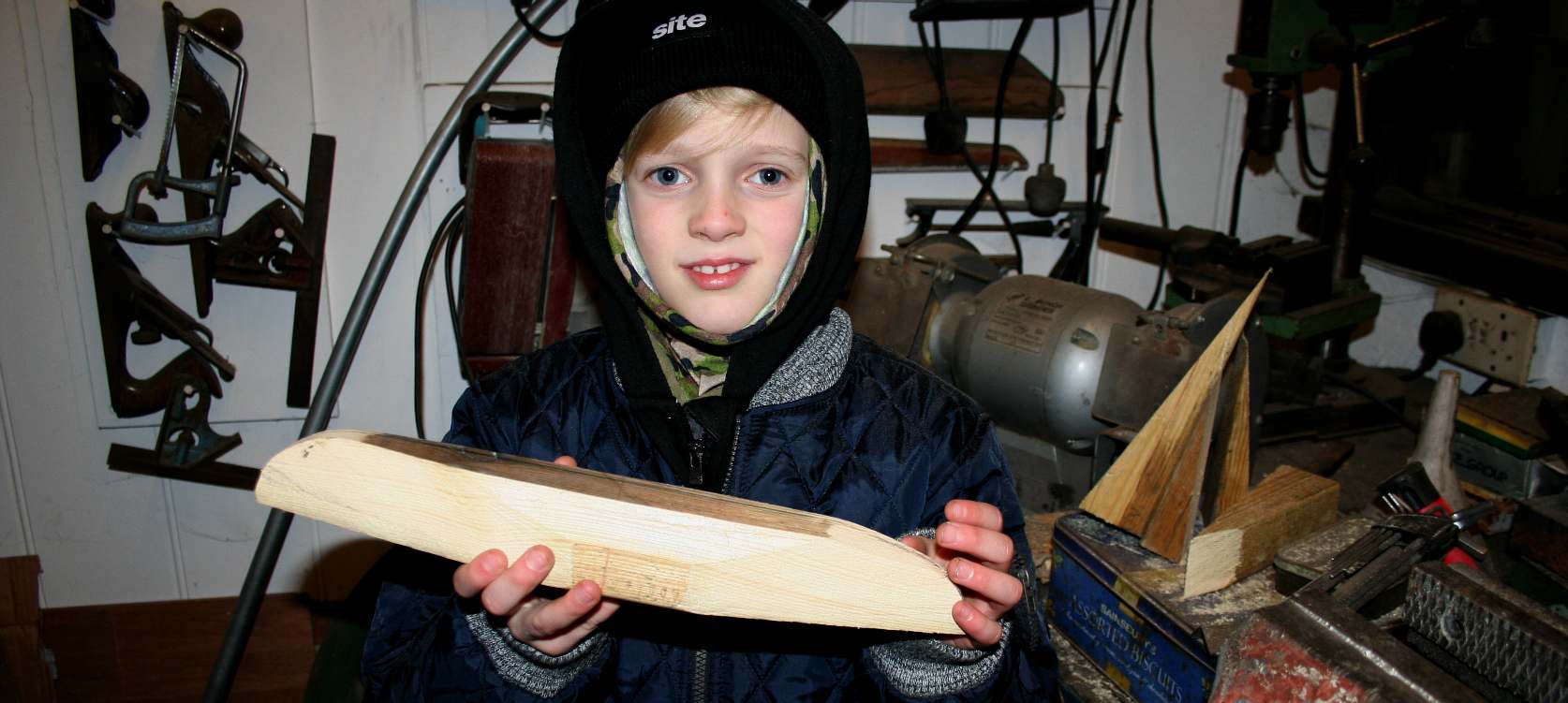
WOODEN
BLANK - Ryan Dusart (8) is seen here holding a completed wooden (pine,
softwood) blank made from building off-cuts. This will be the hull of his
model longboat. He is making a scale replica of the Gokstad ship, a 9th-century Viking ship found in a burial mound at Gokstad in Sandar, Sandefjord, Vestfold, Norway.
This ship is currently on display at the Viking Ship Museum in Oslo, Norway.
Copyright photograph January 22 2017, all rights reserved.
You will need the permission of Bluebird Marine Systems Ltd to reproduce
this picture.
This
page is all about Viking longboats and the Norsemen that plundered and
traded their way around Europe. We also feature the build of a small scale
replica of one of these famous dragon ships, in connection with a homework
project that was assigned to the pupils at a school in Sussex,
England, where there is a strong wooden boat building tradition.
When Ryan was making this model he learned a
great many DIY skills/ These included:
1.
That a sharp pencil is the most important tool in the workshop.
2.
That a good ruler or tape measure is vital equipment.
3.
That using a workshop is a good idea, though it is possible to use your
bedroom,
except for painting a model that should be done in a well
ventilated area if using solvent based
paints.
4.
How to cut angles in wood
along and diagonally to the grain.
5.
How to plane wood to make curved, rather than flat surfaces.
6.
How to use abrasive coated papers (sand or production paper) to roughly
shape an object.
7.
How to use fine, 120-240, grit production paper
NORSEMEN
Norsemen are the group of people who spoke what is now called the Old Norse language between the 8th and 11th centuries. The language belongs to the North Germanic branch of the Indo-European languages, and is the earlier form of modern Scandinavian languages.
Norseman means "man from the North" and applied primarily to Old Norse-speaking tribes living in southern and central Scandinavia. In history, "Norse" or "Norseman" could be any person from Scandinavia, even though Norway, Denmark and Sweden were different sets of people by the Middle Ages.
Typically the term Norse refers to the West Norse, meaning mainly Norwegians when reading about settlements in and colonization of
America, Normandy,
Iceland, Greenland, Ireland, Scotland,
Wales, Shetland, Orkney, the Hebrides, the Faroe Islands and Mann. In some other historical references, the term may also refer to the East Norse, meaning mainly Danes and Swedes, for instance, Cnut's Empire and Swedes adventures East.
The Norse Scandinavians established states and settlements in England, Scotland, Iceland, Wales, the Faroe Islands, Finland,
Ireland, Russia, Greenland,
France, Belgium, Ukraine, Estonia, Latvia, Lithuania,
Germany, Poland, and
Canada as well as southern Italy.
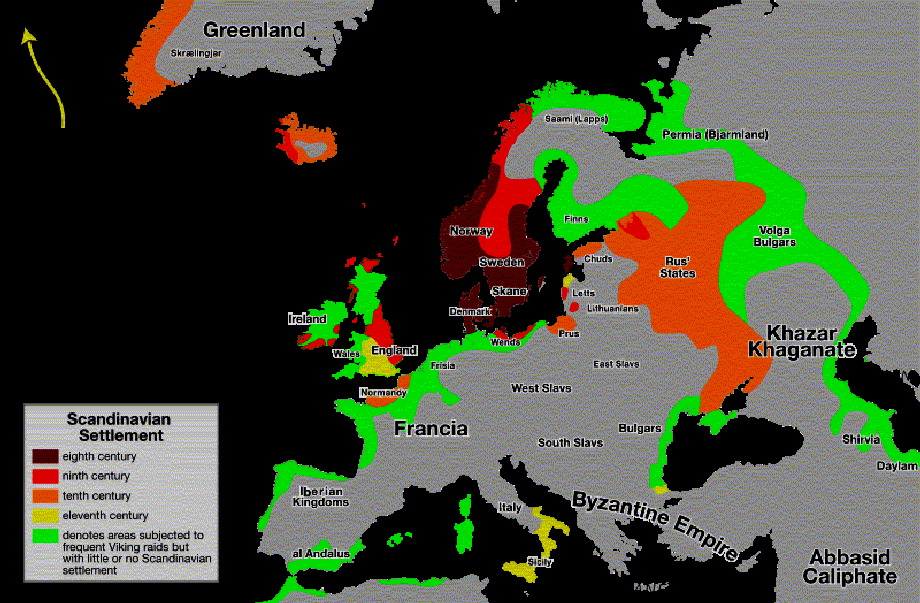
SCANDINAVIAN
SETTLEMENTS
- This is a map of Europe showing when various land masses were occupied
by the Vikings.
VIKINGS
Vikings (Danish and Bokmål:
vikinger; Swedish and Nynorsk: vikingar; Icelandic: víkingar), from Old Norse víkingr, were Nordic seafarers, mainly speaking the Old Norse language, who raided and traded from their Northern European homelands across wide areas of northern, central and eastern Europe, during the late 8th to late 11th centuries. The term is also commonly extended in modern English and other vernaculars to the inhabitants of Viking home communities during what has become known as the Viking Age. This period of Nordic military, mercantile and demographic expansion constitutes an important element in the early medieval history of Scandinavia, Estonia, the
British
Isles, France, Kievan Rus' and Sicily.
Facilitated by advanced seafaring skills, and characterised by the longship, Viking activities at times also extended into the
Mediterranean littoral, North
Africa, the Middle East and Central Asia. Following extended phases of (primarily sea- or river-borne) exploration, expansion and settlement, Viking (Norse) communities and polities were established in diverse areas of north-western Europe, European
Russia, the North
Atlantic islands and as far as the north-eastern coast of North America. This period of expansion witnessed the wider dissemination of Norse culture, while simultaneously introducing strong foreign cultural influences into Scandinavia itself, with profound developmental implications in both directions.
Popular, modern conceptions of the Vikings - the term frequently applied casually to their modern descendants and the inhabitants of modern
Scandinavia - often strongly differ from the complex picture that emerges from archaeology and historical sources. A romanticized picture of Vikings as noble savages began to emerge in the 18th century; this developed and became widely propagated during the 19th-century Viking revival. Perceived views of the Vikings as alternatively violent,
piratical heathens or as intrepid adventurers owe much to conflicting varieties of the modern Viking myth that had taken shape by the early 20th century. Current popular representations of the
Vikings are typically based on cultural clichés and stereotypes, complicating modern appreciation of the Viking legacy.
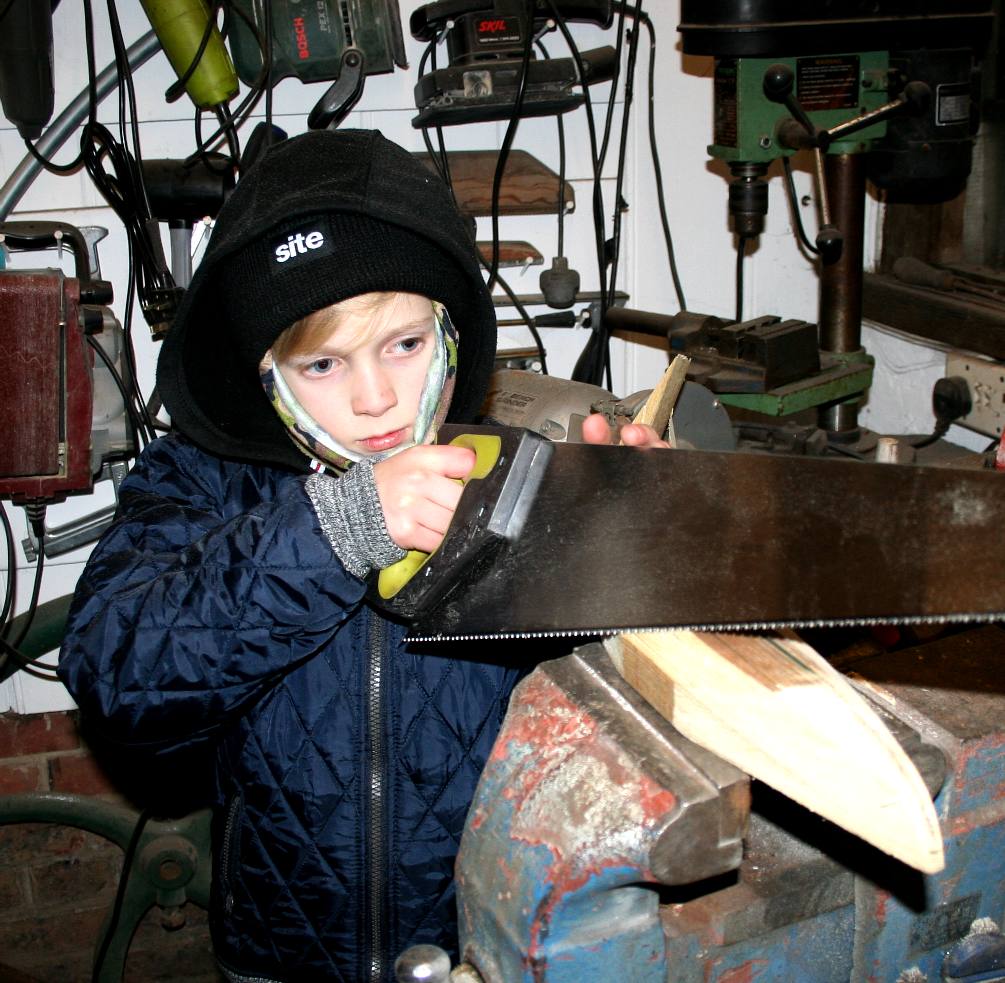
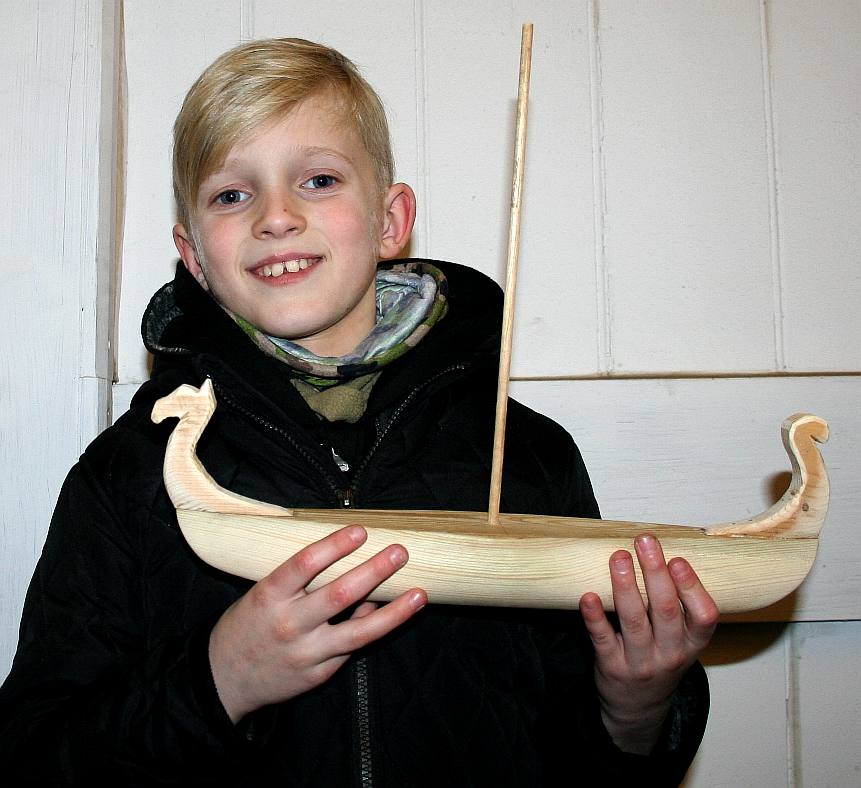
HOMEWORK
PROJECT - Honing up his woodworking skills in a cold workshop in
winter, Ryan helped to sculpt this scale model of a Viking
longboat using scraps of wood he scavenged from the off-cuts pile. He was
carefully supervised throughout the two hours it took to research the
subject and then to carve this model. He was given tuition as to how to
cut wood
safely using a vice and other equipment. Copyright photographs, 22 January
2017, all rights reserved.
You will need the permission of Bluebird Marine Systems Ltd to reproduce
this picture.
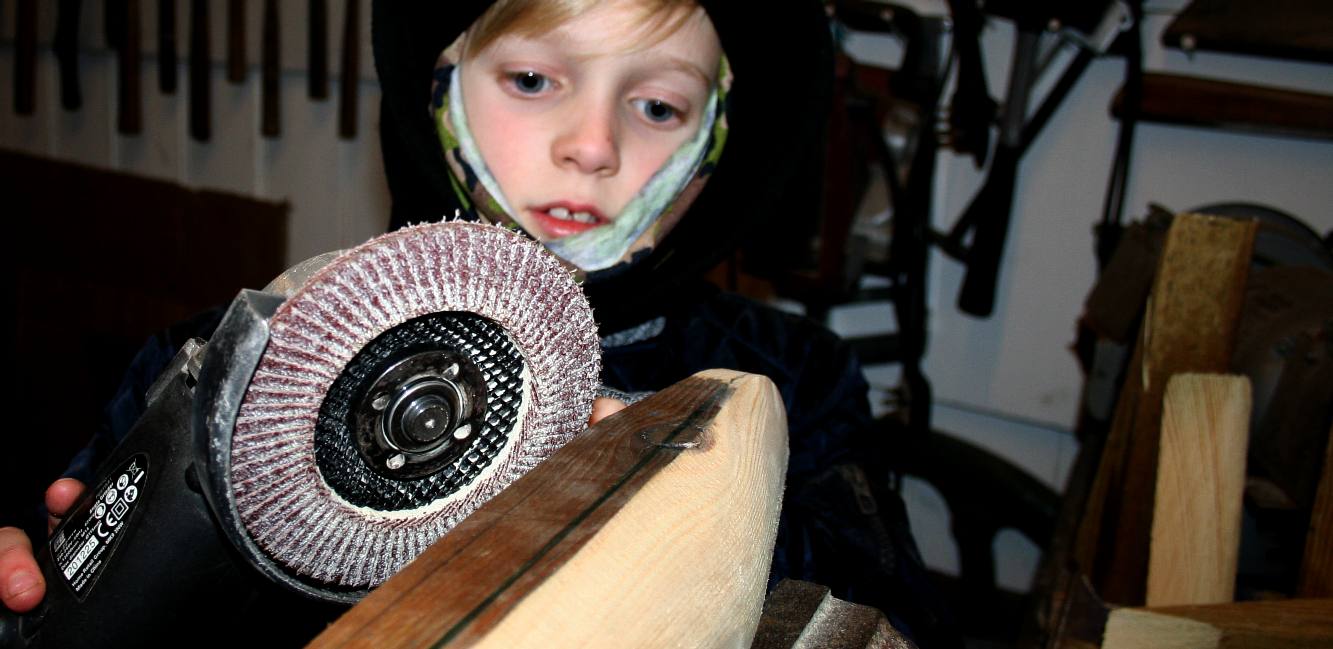
POWER
SANDING
- Unfortunately, much as Ryan wanted to have a go with this power tool, it
is much to powerful and dangerous for a schoolboy to handle. If you want
to speed up the making of your model and you know a skilled adult who has
such an item, it will not hurt to ask for help. Otherwise use a plane,
rough wood file or 40 grit production paper on a rubber
or wooden block. Copyright photographs, 22 January
2017, all rights reserved.
You will need the permission of Bluebird Marine Systems Ltd to reproduce
this picture.
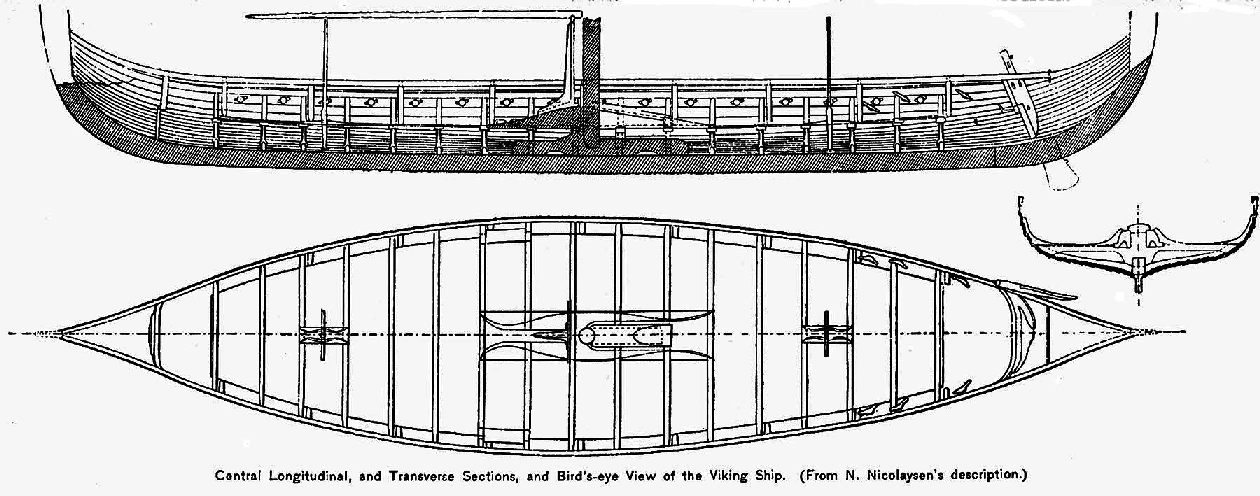
INSPIRATION
- These are the plans of the Gokstad, a Viking ship that is typical of the
longboat style they developed for their explorations around the coasts and
oceans of Europe, Greenland and Iceland. The plans are not that accurate,
but are sufficient for Ryan to be able to construct a model in a short
timescale.
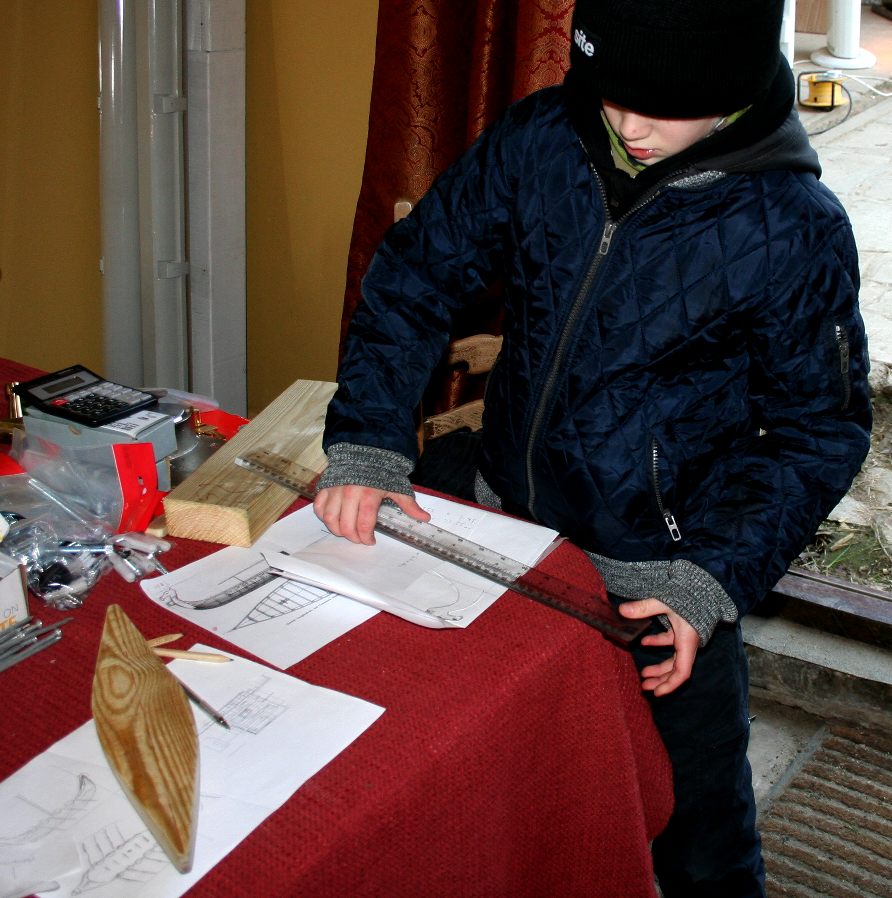
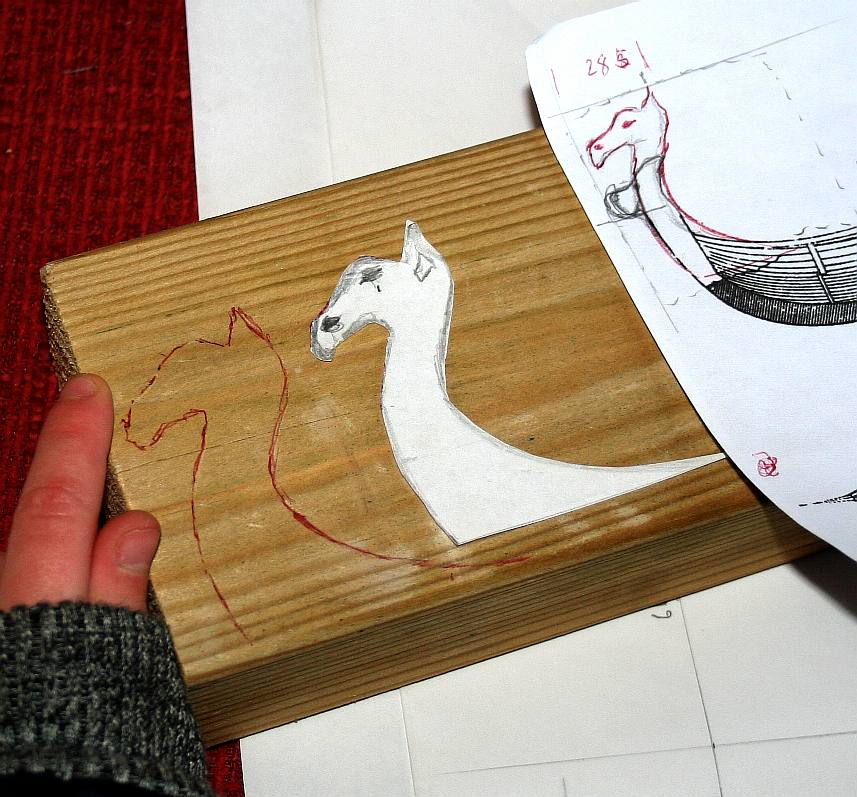
THINKING
CAP
- With his thinking cap firmly affixed to his head, Ryan transfers a
number of reference points from the drawings he has found online. The
enlarged art is then cut out to make a template to mark out the wooden
banks. Copyright photograph, 22 January 2017, all rights reserved.
You will need the permission of Bluebird Marine Systems Ltd and Ryan
Dusart to be able to reproduce these pictures except for private study and
research or educational
purposes.
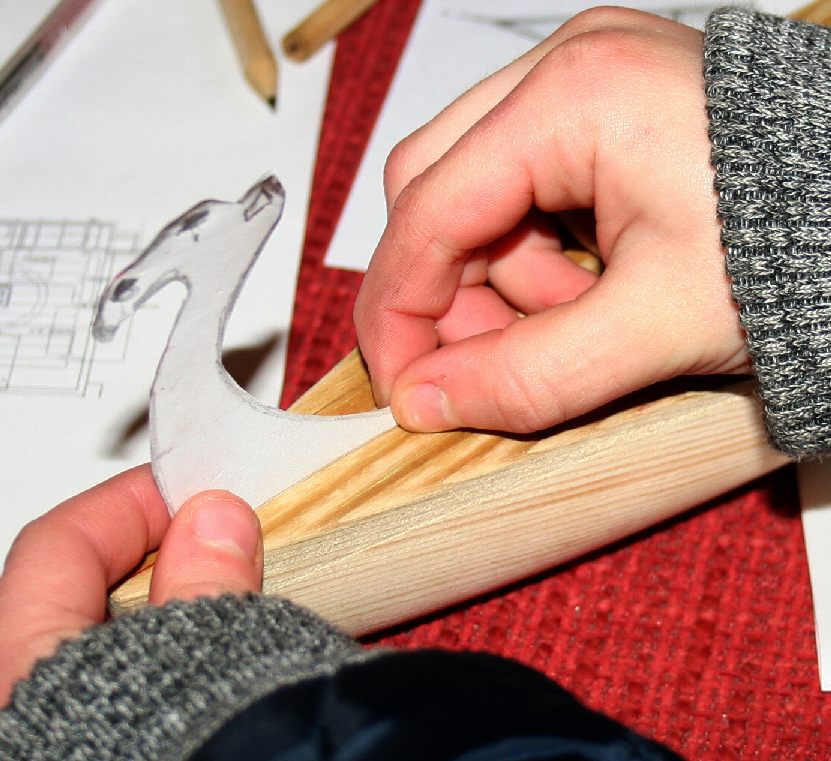
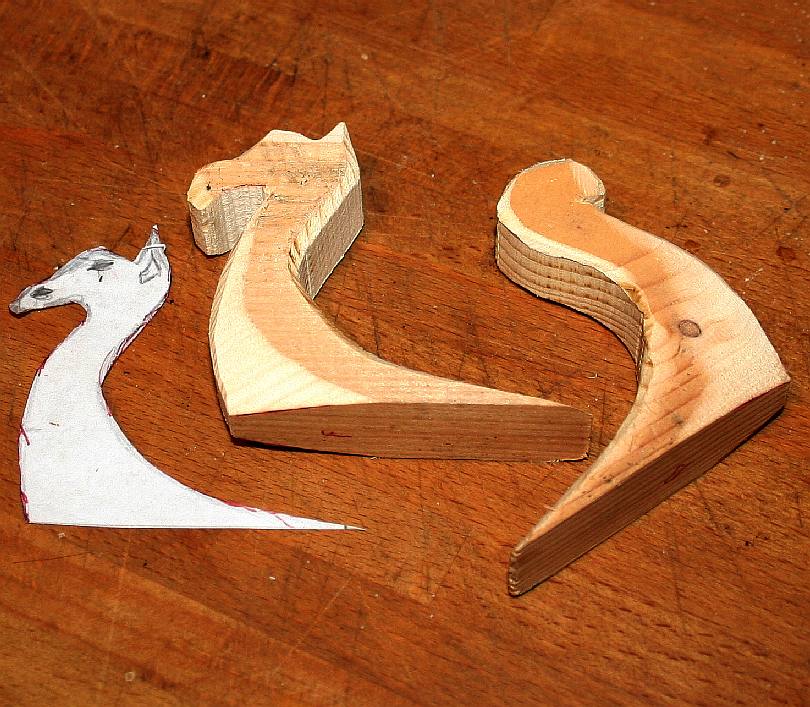
TESTING
- The wooden blanks are transformed into half sensible head and tail
sections. Copyright photograph, 22 January 2017, all rights reserved.
You will need the permission of Bluebird Marine Systems Ltd and Ryan
Dusart to be able to reproduce these pictures except for private study and
research or educational
purposes.

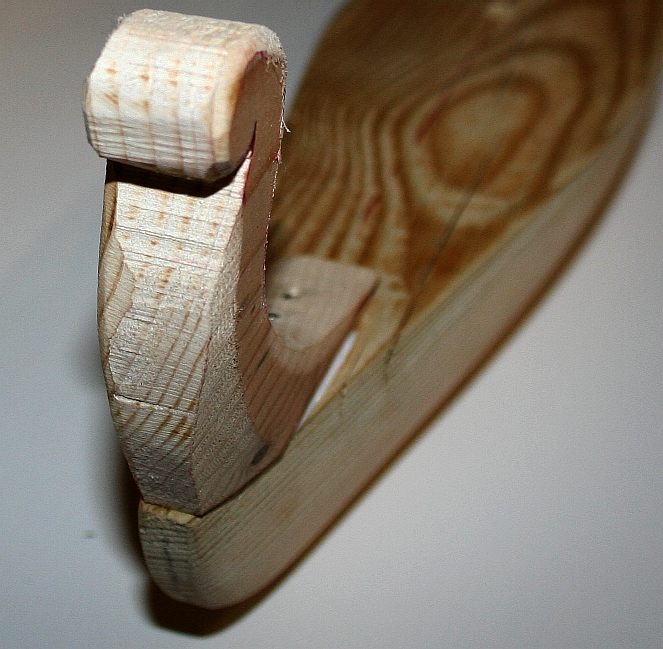
HEADS
OR TAILS - These were cut roughly with a 4 1/2" angle grinder
fitted with a flappy-disc made of small sheets of 60 grit production
paper. They now need to be fine carved and sanded before the model boat is
varnished. Copyright photograph, 22 January 2017, all rights reserved.
You will need the permission of Bluebird Marine Systems Ltd and Ryan
Dusart to be able to reproduce these pictures except for private study and
research or educational
purposes.
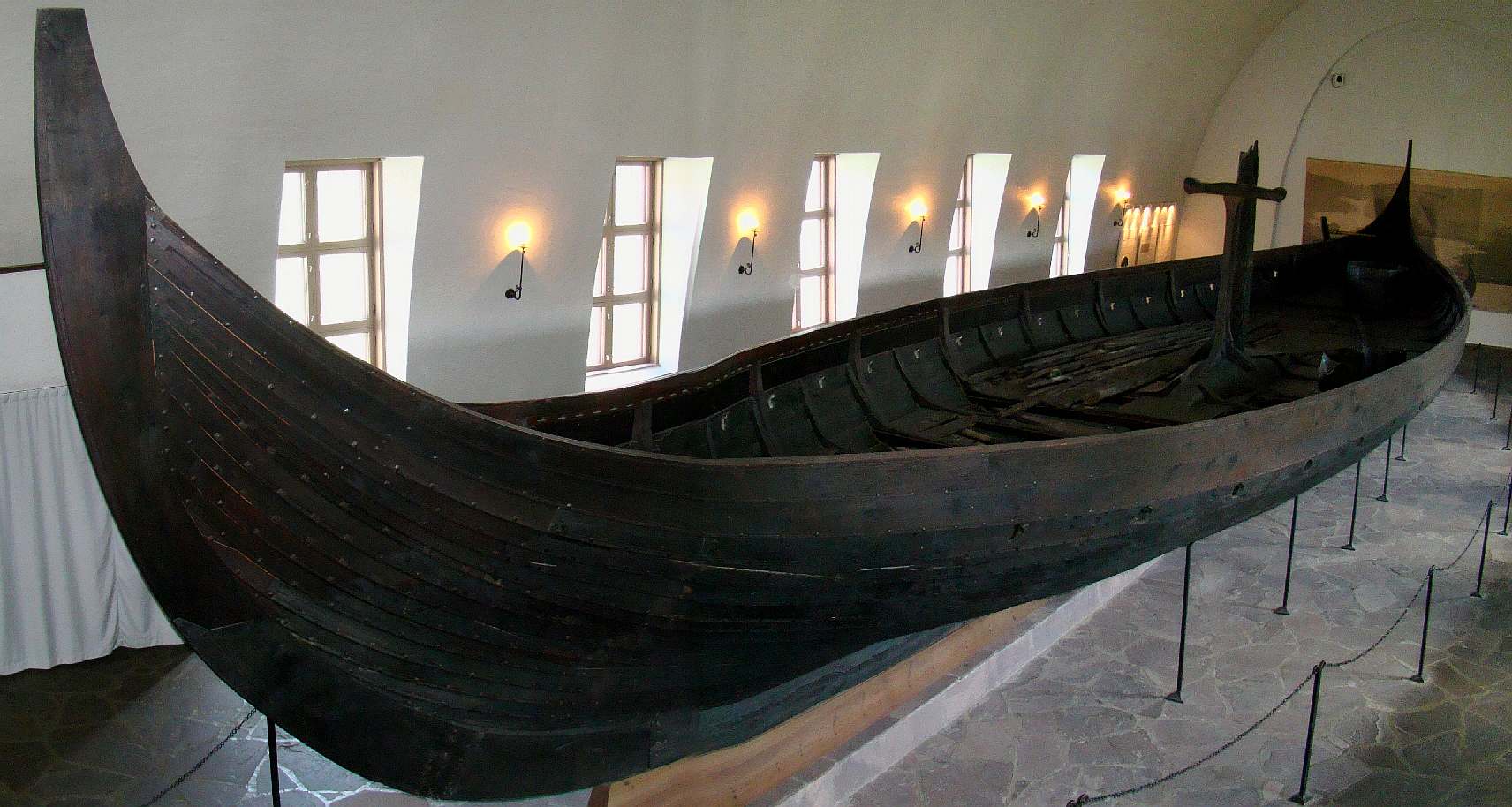
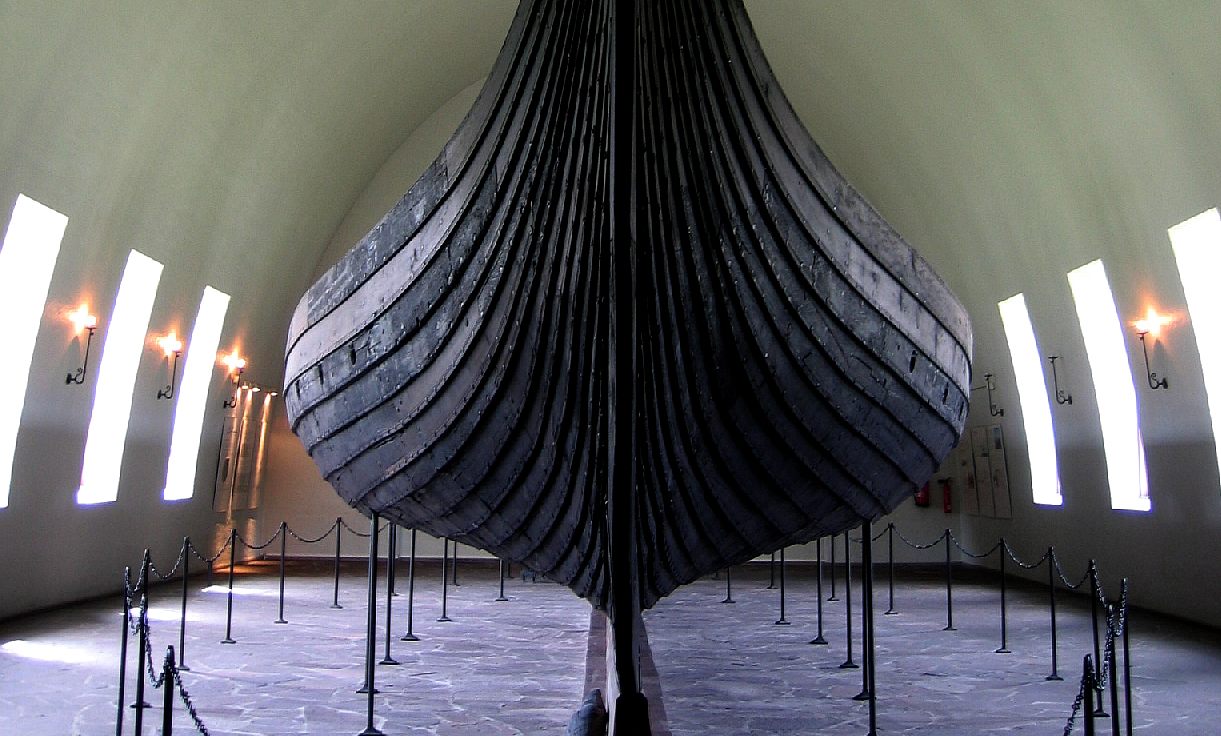
CLINKER
BUILT HULL - An amazing sight for any boat enthusiast or
archaeologist, the hull of the Gokstad rests on its keel surrounded by
steel supports and ropes to prevent the public from spoiling the wood with
acidic residues and sticky, chocolate covered fingers.
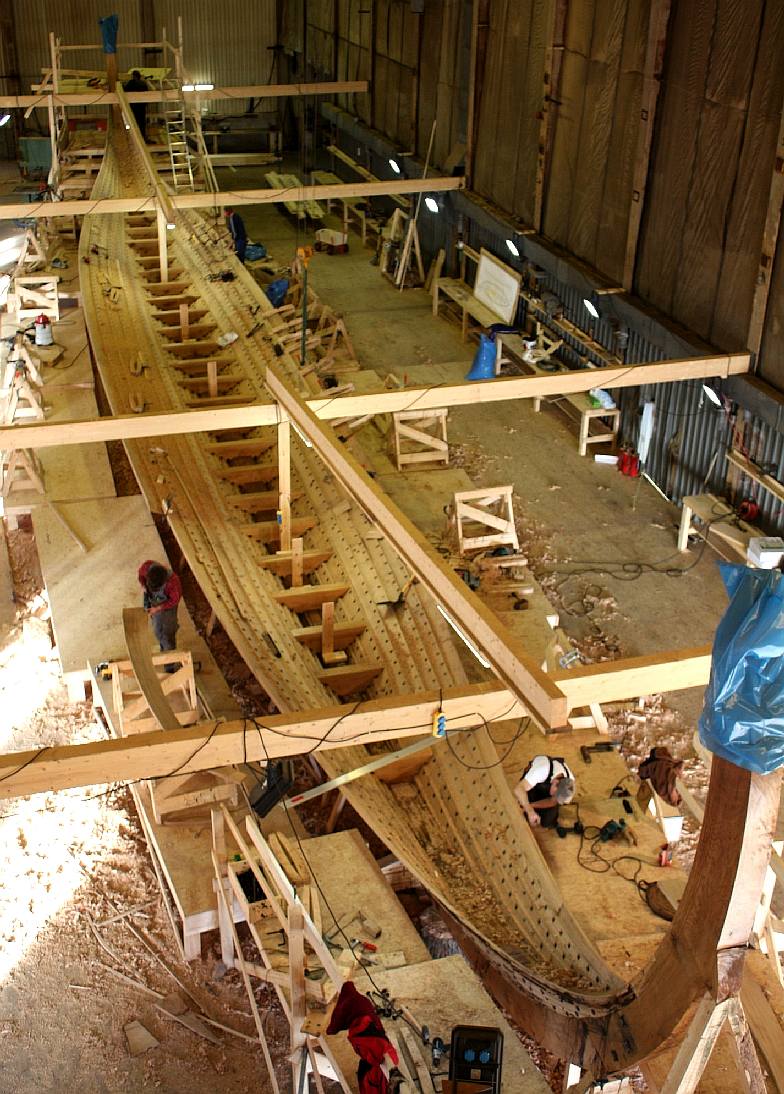
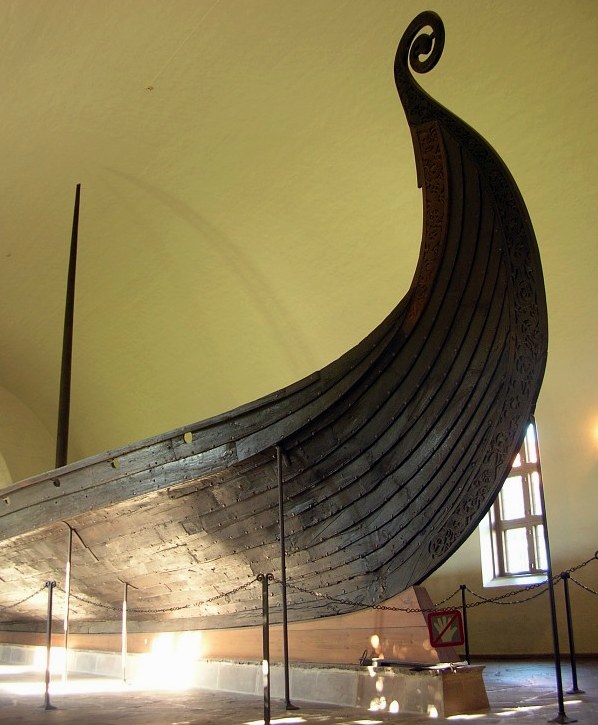
WORKSHOP
& MUSEUM
DISPLAY
- [LEFT] A replica of a Viking longship being built in modern times.
[RIGHT] A real Viking ship on display in Oslo having been discovered and
recovered. Oslo is the capital of Norway. The city sits on the country’s southern coast at the head of the Oslofjord. It’s known for its green spaces and museums. Many of these are on the Bygdøy Peninsula, including the waterside Norwegian Maritime Museum and the Viking Ship Museum, with Viking ships from the 9th century. The Holmenkollbakken is a ski-jumping hill with panoramic views of the fjord. It also has a
ski museum.

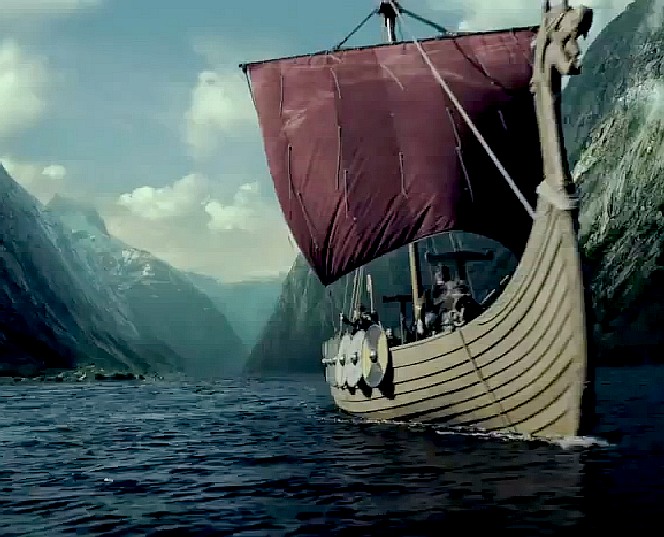

CLASSIC
ART
- These are a few of the stunning pictures that artists have produced to
depict Norse maritime history.
Longships were a type of ship invented and used by the Norsemen for trade, commerce, exploration, and warfare during the Viking Age. The longship's design evolved over many centuries, beginning in the Stone Age with the invention of the umiak and continuing up until the 6th century with clinker built ships like Nydam and Kvalsund. The longship appeared in its complete form between the 9th and 13th centuries. The character and appearance of these ships have been reflected in
Scandinavian boat-building traditions until today. The particular skills and methods employed in making longships are still used worldwide, often with modern adaptations. They were all made out of wood, with cloth sails (woven wool) and had numerous details and carvings on the hull.
The longships were characterized as a graceful, long, narrow and light wooden boat, with a shallow-draft hull designed for speed. The ship's shallow draft allowed navigation in waters only one meter deep and permitted arbitrary beach landings, while its light weight enabled it to be carried over portages or used bottoms up for shelter in camps. Longships were also double-ended, the symmetrical bow and stern allowing the ship to reverse direction quickly without a turn around; this trait proved particularly useful at northern latitudes, where icebergs and sea ice posed hazards to navigation. Longships were fitted with oars along almost the entire length of the boat itself. Later versions had a rectangular sail on a single mast, which was used to replace or augment the effort of the rowers, particularly during long journeys. The average speed of Viking ships varied from ship to ship, but lay in the range of 5–10
knots (9.3–18.5 km/h) and the maximum speed of a longship under favorable conditions was around 15 knots (28 km/h).
The Viking Longships were the epitome of naval power in their time and were highly valued possessions. They were often communally owned by coastal farmers and commissioned by kings in times of conflict, in order to quickly assemble a large and powerful
naval force. While longships were used by the Norse in warfare, they were mostly used for troop transports, not
warships. In the tenth century, longships would sometimes be tied together in offshore battles to form a steady platform for infantry warfare. During the 9th century peak of the Viking expansion, large fleets set out to attack the degrading Frankish empire by attacking up navigable rivers such as the
Seine. Rouen was sacked in 841, the year after the death of Louis the Pious, a son of Charlemagne.
Quentovic, near modern Etables, was attacked in 842 and 600 Danish ships attacked Hamburg in 845. In the same year, 129 ships returned to attack up the Seine. They were called "dragonships" by enemies such as the
English because they had a dragon-shaped bow. The Norse had a strong sense of naval architecture, and during the early medieval period they were advanced for their time.
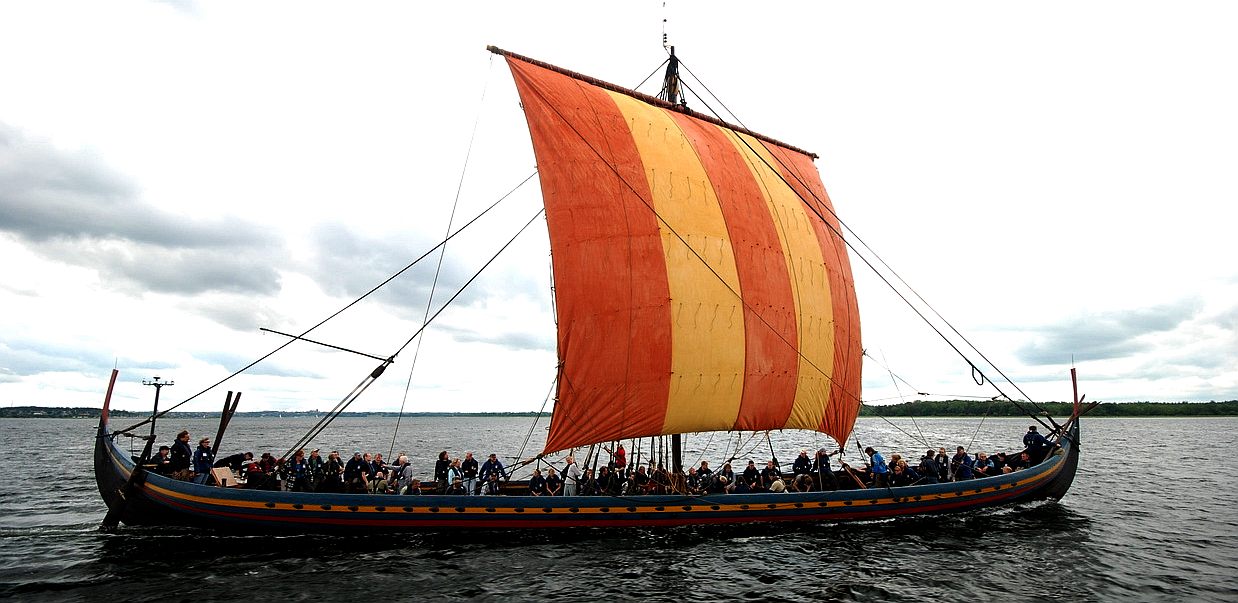
VIKING NAVIGATION
The Vikings were experts in judging speed and wind direction, and in knowing the current and when to expect high and low tides. Viking navigational techniques are not well understood, but historians postulate that the Vikings probably had some sort of primitive astrolabe and used the stars to plot their course.
The Danish archaeologist Thorkild Ramskou suggested in 1967 that the "sun-stones" referred to in some sagas might have been natural crystals capable of polarizing skylight. The mineral cordierite occurring in Norway has the local name "Viking's Compass." Its changes in colour would allow determining the sun's position (azimuth) even through an overcast or foggy
horizon. The sunstones are doubly refracting, meaning that objects viewed through them can be seen as double because of positively charged calcium ions and negatively charged carbonate ions. When looking at the sun the stone, it will project two overlapping shadows on the crystal. The opacities of these shadows will vary depending on the sunstone’s direction to the sun. When the two projected shapes have exactly the same opacity, it means the stone’s long side is facing directly toward the sun. Since the stone uses light polarization, it works the best when the sun is at lower altitudes, or closer to the horizon. It makes sense that Norsemen were able to make use of sunstones, since much of the area they traveled and explored was near
polar, where the sun is very close to the horizon for a good amount of the
year. For example, in the Vinland sagas we see long voyages to North America, the majority sailed at over 60 degrees north.
An ingenious navigation method is detailed in Viking Navigation Using the Sunstone, Polarized Light and the Horizon Board by Leif K. Karlsen. To derive a course to steer relative to the sun direction, he uses a
sun-stone (Solarsteinn) made of Iceland spar (optical calcite or Silfurberg), and a
"horizon-board." The author constructed the latter from an Icelandic saga source, and describes an experiment performed to determine its accuracy. Karlsen also discusses why on North Atlantic trips the Vikings might have preferred to navigate by the sun rather than by stars, as at high latitudes in summer the days are long and the nights short.
A Viking named Stjerner Oddi compiled a chart showing the direction of sunrise and sunset, which enabled navigators to sail longships from place to place with ease. Almgren, an earlier Viking, told of another method: "All the measurements of angles were made with what was called a 'half wheel' (a kind of half sun-diameter which corresponds to about sixteen minutes of arc). This was something that was known to every skipper at that time, or to the long-voyage pilot or kendtmand ('man who knows the way') who sometimes went along on voyages ... When the sun was in the sky, it was not, therefore, difficult to find the four points of the compass, and determining latitude did not cause any problems either." (Algrem)
Birds provided a helpful guide to finding land. A Viking legend states that Vikings used to take caged crows aboard ships and let them loose if they got lost. The crows would instinctively head for land, giving the sailors a course to steer.
Archaeologists have found two devices which they interpret as navigation instruments. Both appear to be sundials with gnomon curves etched on a flat surface. The devices are small enough to be held flat in the hand at 70 mm (2.8 inches) diameter. A wooden version dated to about 1000 AD was found in
Greenland. A stone version was also found at Vatnahverfi, Greenland. By looking at the place where the shadow from the rod falls on a carved curve, a navigator is able to sail along a line of latitude. Both gnomon curve devices show the curve for 60° north very prominently. This was the approximate latitude that the Vikings would have sailed along to get to Greenland from Scandinavia. The wooden device also has north marked and had 32 arrow heads around the edge that may be the points of a
compass. Other lines are interpreted as the solstice and equinox curves. The device was tested successfully, as a sun compass, during a 1984 reenactment when a longship sailed across the North Atlantic. It was accurate to within ± 5°.
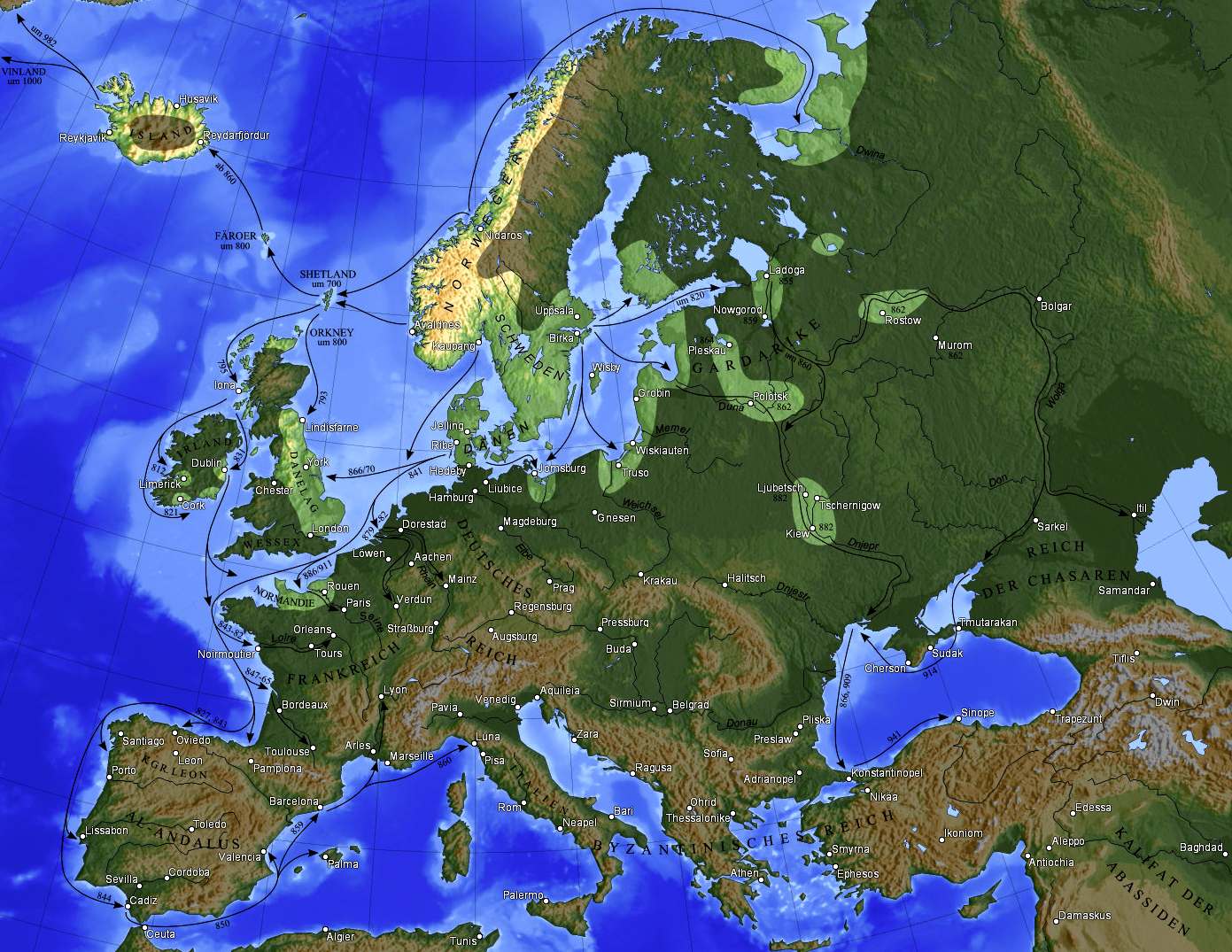
VIKING
NAVIGATION - The above is a map showing the regular routes of Viking
expeditions in and around Europe.
HOW THEY WERE BUILT
The Viking shipbuilders had no written diagrams or standard written design plan. The shipbuilder pictured the longship before its construction, based on previous builds, and the ship was then built from the keel up. The keel and stems were made first. The shape of the stem was based on segments of circles of varying sizes. The keel was an inverted T shape to accept the garboard planks. In the longships the keel was made up of several sections spliced together and fastened with treenails.
The next step was building the strakes – the lines of planks joined endwise from stern to stern. Nearly all longships were clinker (also known as lapstrake) built, meaning that each hull plank overlapped the next. Each plank was hewn from an oak tree so that the finished plank was about 25 mm (0.98 inches) thick and tapered along each edge to a thickness of about 20 mm (0.79 inches). The planks were radially hewn so that the grain is approximately at right angles to the surface of the plank. This provides maximum strength, an even bend and an even rate of expansion and contraction in water. In modern terms this is called quarter sawn timber and has the least natural shrinkage of any cut section of wood. The plank above the turn of the bilge, the meginhufr, was about 37 mm (1.5 inches) thick on very long ships, but narrower to take the strain of the crossbeams. This was also the area subject to collisions. The planks overlapped by about 25 mm (0.98 inches)–30 mm (1.2 inches) and were joined by iron rivets. Each overlap was stuffed with wool or animal hair or sometimes hemp soaked in pine tar to ensure water tightness.
At midlength, where the planks are straight, the rivets are about 170 mm (6.7 inches) apart but were closer together as the planks sweep up to the curved bow and stern. There is considerable twist and bend in the end planks. This was achieved by using both thinner (by 50%) and narrower planks. In more sophisticated builds, forward planks were cut from natural curved trees called reaction wood. Planks were installed unseasoned or wet. Partly worked stems and sterns have been located in bogs. It has been suggested they were stored there over winter to stop the wood drying and cracking. The moisture in wet planks allowed the builder to force the planks into a more acute bend if need be. Once dry it would stay in the forced position. At the bow and the stern builders were able to create hollow sections, or compound bends, at the waterline making the entry point very fine. In less sophisticated ships short and nearly straight planks were used at the bow and stern. Where long timber was not available, or the ship was very long, the planks were butt joined although over lapping scarf joints, fixed with nails were also used.
As the planks reached the desired height, the interior frame (futtocks) and cross beams were added. Frames were placed close together, which is an enduring feature of thin planked ships, still used today on some lightweight wooden racing craft such as those designed by Bruce Farr. Viking boat builders used a spacing of about 850 mm (33 inches). Part of the reason for this spacing was to achieve the correct distance between rowing stations and to create space for the chests used by Norse sailors as thwarts (seats). The bottom futtocks next to the keel were made from natural L-shaped crooks. The upper futtocks were usually not attached to the lower futtocks to allow some hull twist. The parts were held together with iron rivets, hammered in from the outside of the hull and fastened from the inside with a rove (washers). The surplus rivet was then cut off. A ship normally used about 700 kg (1,500 pounds) of
iron nails in a 18 m (59 feet) long ship. In some ships the gap between the lower uneven futtock and the lapstrake planks was filled with a spacer block about 200 mm (7.9 inches) long. In later ships spruce stringers were fastened lengthwise to the futtocks roughly parallel to the keel. Longships had about five rivets for each yard (90 cm or 35 inches) of plank. In many early ships treenails (trenails, trunnels) were used to fasten large timbers. First, a hole about 20 mm (0.79 inches) wide hole was drilled through two adjoining timbers, a wooden pegs inserted which was split and a thin wedge inserted to expand the peg. Some treenails have been found with traces of linseed oil suggesting that treenails were soaked before the pegs were inserted. When dried the oil would act as a semi waterproof weak filler/glue.
The longships' narrow deep keel provided strength beneath the waterline. A typical size keel of a longer ship was 100 mm × 300 mm (3.9 by 11.8 inches) amidships, tapering in width at the bow and stern. Sometimes there was a false outer keel to take the wear while being dragged up a beach. These large timbers were shaped with both adze and broadaxe. At the bow the cut water was especially strong, as longboats sailed in ice strewn water in spring. Hulls up to 560 cm (18.4 feet) wide gave stability, making the longship less likely to tip when sailed. The greater beam provided more moment of leverage by placing the crew or any other mobile weight on the windward side. Oceangoing longships had higher topsides about a 1 m (3.3 feet) high to keep out water. Higher topsides were supported with knees with the long axis fastened to the top of the crossbeams. The hull was waterproofed with animal hair, wool, hemp or moss drenched in pine tar. In the autumn the ships would be tarred and then left in a boathouse over the winter to allow time for the tar to dry. To keep the sea out, wooden disks were put into the oar holes. These could be shut from the inside when the oars were not in use. A drain plug hole about 25 mm (0.98 inches) was drilled in the garboard plank on one side to allow rain water drainage.
The oars did not use rowlocks or thole pins but square holes cut below the gunwale line. The holes were also used for belaying mooring lines and sail sheets. At the bow the forward upper futtock protruded about 400 mm (16 inches) above the sheerline and was carved to retain anchor or mooring lines.
MAST & SAILS
Even though no longship sail has been found, accounts and depictions verify that longships had square sails. Sails measured perhaps 11 m (35 feet) to 12 m (40 feet) across, and were made of rough wool cloth. Unlike in knarrs, a longship sail was not stitched.
The sail was held in place by the mast which was up to 16 m (52 feet) tall. Its base was about 250 mm × 180 mm (9.8 by 7.1 inches). The mast was supported by a large wooden maststep called a kerling ("Old Woman" in Old Norse) that was semicircular in shape. (Trent) The kerling was made of oak, and about 700 mm (28 inches) wide and up to 6 m (20 feet) long in the larger ships. It usually heavily tapered into a joint with the internal keelson, although keelsons were by no means universal. The kerling lay across two strong frames that ran width-wise above the keel in the centre of the boat. The kerling also had a companion: the "mast fish," a wooden timber above the kerling just below deck height that provided extra help in keeping the mast erect. It was a large wooden bulk of timber about 3 m (9.8 feet) long with a 1.4-metre long (4.6 ft) slot, facing aft to accommodate the mast as it was raised. This acted as a mechanism to catch and secure the mast before the stays were secured. It was an early form of mast partner but was aligned fore and aft. In later longships there is no mast fish-the mast partner is an athwartwise beam similar to more modern construction. Most masts were about half the length of the ship so that it did not project beyond the hull when unstepped. When lowered the mast foot was kept in the base of the mast step and the top of the mast secured in a natural wooden crook about 1.5–2.5 m (4 feet 11 inches–8 feet 2 inches) high, on the port side, so that it did not interfere with steering on the starboard side.
There is a suggestion that the rig was sometimes used in a lateen style with the top cross spar dipped at an angle to aid sailing to windward i.e. the spar became the luff. There is little or no evidence to support this theory. No explanation is offered as to how this could be accomplished with a square sail as the lower reefed portion of the sail would be very bulky and would prevent even an approximation of the laminar flow necessary for windward sailing. There is no evidence of any triangular sails in use. Masts were held erect by side stays and possibly fore and aft stays. Each side stay was fitted at it lower end with a 150-millimetre long (5.9 in) toggle. There were no chain plates. The lower part of the side stay consisted of ropes looped under the end of a knee of upper futtock which had a hole underneath. The lower part of the stay was about 500–800 mm (1.6–2.6 feet) long and attached to a combined flat wooden turnblock and multi V jamb cleat called an
angel (maiden,
virgin). About 4 turns of
rope went between the angel and the toggle to give the mechanical advantage to tighten the side stays. At each turn the v shape at the bottom of the angels "wings" jambed the stay preventing slippage and movement.
OARS FOR ROWING
The longships had two methods of propulsion: oars and sail. At sea, the sail enabled longships to travel faster than by oar and to cover long distances overseas with far less manual effort.
Sails could be raised or lowered quickly. In a modern facsimile the mast can be lowered in 90 seconds. Oars were used when near the coast or in a river, to gain speed quickly, and when there was an adverse (or insufficient) wind. In combat, the variability of wind power made rowing the chief means of propulsion. The ship was steered by a vertical flat blade with a short round handle, at right angles, mounted over the starboard side of the aft gunwale.
Longships were not fitted with benches. When rowing, the crew sat on sea chests (chests containing their personal possessions) that would otherwise take up space. The chests were made the same size and were the perfect height for a Viking to sit on and row. Longships had hooks for oars to fit into, but smaller oars were also used, with crooks or bends to be used as oarlocks. If there were no holes then a loop of rope kept the oars in place.
An innovation that improved the sail's performance was the beitass, or stretching pole – a
wooden spar stiffening the sail. The windward performance of the ship was poor by modern standards as there was no centreboard, deep keel or leeboard. To assist in tacking the beitass kept the luff taut. Bracing lines were attached to the luff and led through holes on the forward gunwale. Such holes were often reinforced with short sections of timber about 500 to 700 mm (1.6 to 2.3 feet) long on the outside of the hull.
RUDDERS
Early long boats used some form of steering oar but by the 10th century the side
rudder (called a steerboard, the source for the etymology for the word starboard itself) was well established. It consisted of a length of timber about 2.4 m (7 feet 10 inches) long. The upper section was rounded to a diameter of about 150 mm (5.9 inches). The lower blade was about 1.8 m × 0.4 m (5 feet 11 inches by 1 foot 4 inches). The steerboard on the Gokstad ship in the Viking Ship Museum in Oslo,
Norway, is about 20 cm (8 inches) wide, completely flat inboard and with about a 7.6 cm (3 inches) maximum width at the center of the
foil. The head of the rudder shaft had two square holes about 200–300 mm (7.9–11.8 inches) apart. When the rudder was in its normal position the tiller was inserted in the upper hole so that the tiller faced athwartwise. The shaft was attached to the gunwale by a U shaped joint. Near the stern, about halfway down the starboard topsides, was a rounded wooden block about 150 mm (5.9 inches) in diameter and 100 mm (3.9 inches) high, with a central hole for a rope. This corresponded to a hole in the midsection of the rudder blade. From the outside the rope ran through the blade, through the round block and topsides and was fastened inside the hull. The flexibility of the hemp rope allowed the blade to pivot. When beached or in shallow water the tiller was moved to the lower hole, the blade rope was slackened and the rudder head pulled up so the rudder could operate in shallow
waters. Modern facsimiles are reported to steer quite well but require a very large amount of physical effort compared to the modern fore and aft tiller.
ANCHORING
Longships for the most part used two different kinds of anchors. The most common was a natural wood yoke formed from a tree branch. The weight was supplied by a stone passing laterally through the U of the yoke. The top of the yolk was closed by either a length of hardwood or a curved iron head, which kept the stone in place. One side of the head stuck out so it could dig into mud or sand. In the Ladby ship burial in Denmark, a unique iron anchor has been found, resembling the modern fisherman's anchor but without the crossbar. The cross bar may have rusted away. This anchor - made of Norwegian iron - has a long iron chain to which the hemp warp was attached. This construction has several advantages when anchored on deep waters or in
rough seas.
GOKSTAD CONSTRUCTION
The Gokstad ship is clinker-built and constructed largely of oak. The ship was intended for warfare, trade, transportation of people and cargo. The ship is 23.80 metres (78.1 ft) long and 5.10 m (16.7 ft) wide. It is the largest in the Viking Ship Museum in Oslo. The ship was steered by a quarter rudder fastened to a large block of wood attached to the outside of the hull and supported by an extra stout rib. The block is known as the wart, and is fastened by osiers, knotted on the outside passed through both the rudder and wart to be firmly anchored in the ship.
There are 16 tapered planks per side. The garboard planks are near vertical where they attach to the keel. The garboard planks are narrow and remain only slightly wider to take the turn of the bilge. The topside planks are progressively wider. Each oak plank is slightly tapered in cross section to allow it to overlap about 30mm the plank above and below in normal clinker (lapstrake) style. Iron rivets are about 180 mm apart where the planks lie straight and about 125 mm apart where the planks turn.
At the bow, all of the planks taper to butt the stem. The stem is carved from a single curved oak log to form the cutwater and has one land for each plank. The inside of the stem is hollowed into a v shape so the inside of the rivets can be reached during construction or repair. Each of the crossbeams has a ledge cut about 25 mm wide and deep to take a removable section of decking. Sea chests were placed on top of the decking to use when
rowing. Most likely on longer voyages sea chests were secured below decks to act as ballast when sailing. The centre section of the keel has little rocker and together with flat midships transverse section the hull shape is suited to medium to flat water sailing. When sailing downwind in strong winds and waves, directional control would be poor, so it is likely that some reefing system was used to reduce sail area. In such conditions the ship would take water aboard at an alarming rate if sailed at high speed.
The ship was built to carry 32 oarsmen, and the oar holes could be hatched down when the ship was under sail. It utilized a square sail of approximately 110 square metres (1,200 sq ft), which, it is estimated, could propel the ship to over 12 knots (22 km/h; 14 mph). The mast could be raised and lowered. While the ship was traveling in shallow water, the rudder could be raised very quickly by undoing the fastening. Dendrochronological dating suggests that the ship was built of timber that was felled around 890 AD. This period is the height of Norse expansion in Dublin, Ireland and York, England. The Gokstad ship was commissioned at the end of the 9th century during the reign of King Harald Fairhair. The ship could carry a crew of 40 men but could carry a maximum of 70. The ship's design has been demonstrated to be very seaworthy.
LEARNING
OUTCOME
From
this project Ryan learned a great deal about scaling drawings that are
available from the web to be able to make a historic model to scale:
8.
How to define a mathematical multiplier and apply the figure to create an
accurate model.
9.
How to cut draw and mark out a paper template.
10.
How a bandsaw works, but is too dangerous for children to use.
11.
How effective a rotary disc sander can be; also too dangerous for children
to operate.
By
the end of the day, Ryan had (with a little help) made his first scale
model boat and learned a huge amount about Vikings and their famous long
ships.
LINKS
& REFERENCE
https://en.wikipedia.org/wiki/Longship https://en.wikipedia.org/wiki/Norsemen
http://www.yacht.de/artikel/a73151/bild/3141179.html
https://en.wikipedia.org/wiki/Vikings
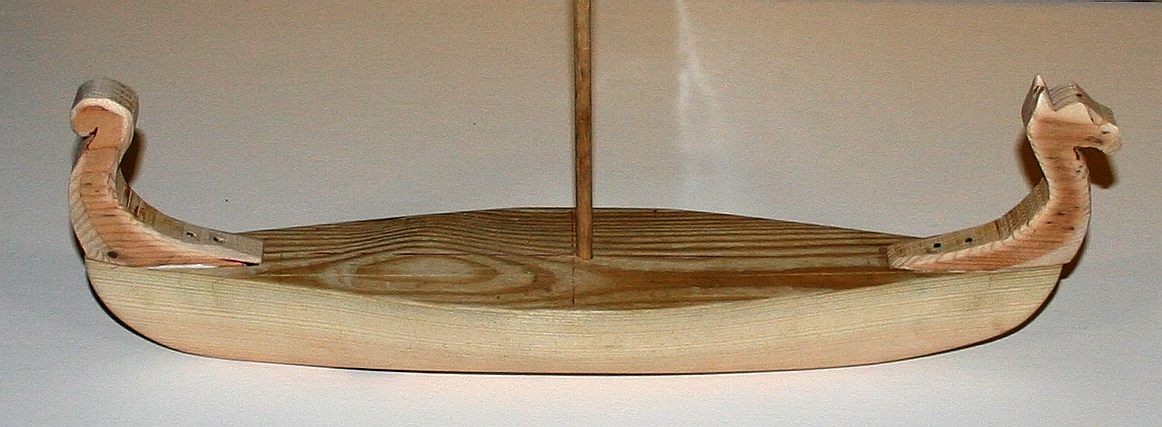
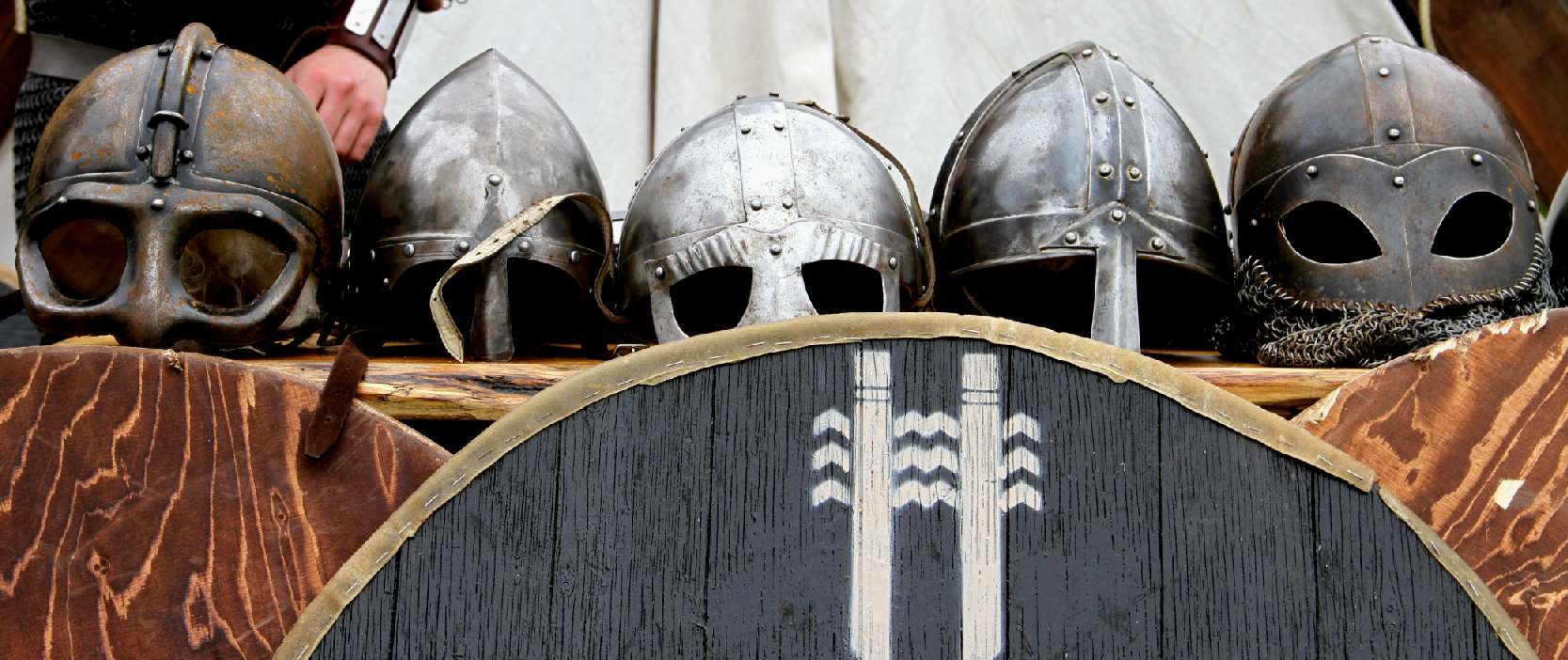
|




















